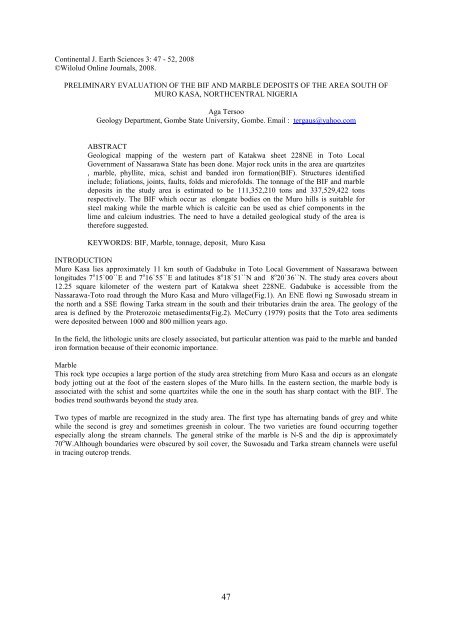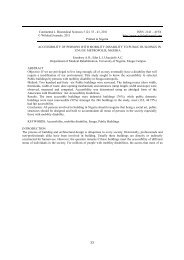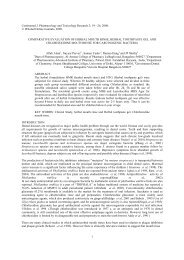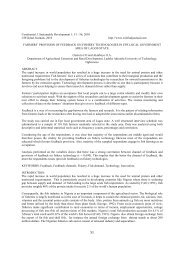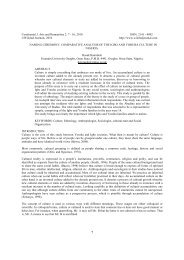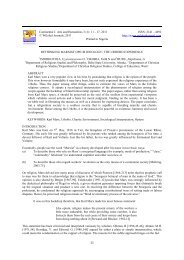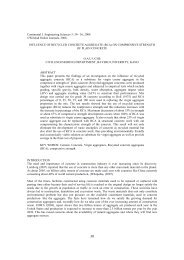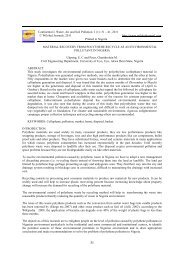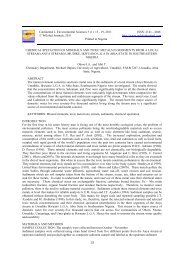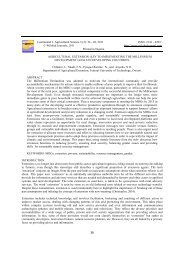Continental J. Earth Sciences 3: 47 - 52, 2008 ... - Wilolud Journals
Continental J. Earth Sciences 3: 47 - 52, 2008 ... - Wilolud Journals
Continental J. Earth Sciences 3: 47 - 52, 2008 ... - Wilolud Journals
Create successful ePaper yourself
Turn your PDF publications into a flip-book with our unique Google optimized e-Paper software.
<strong>Continental</strong> J. <strong>Earth</strong> <strong>Sciences</strong> 3: <strong>47</strong> - <strong>52</strong>, <strong>2008</strong>©<strong>Wilolud</strong> Online <strong>Journals</strong>, <strong>2008</strong>.PRELIMINARY EVALUATION OF THE BIF AND MARBLE DEPOSITS OF THE AREA SOUTH OFMURO KASA, NORTHCENTRAL NIGERIAAga TersooGeology Department, Gombe State University, Gombe. Email : tergaus@yahoo.comABSTRACTGeological mapping of the western part of Katakwa sheet 228NE in Toto LocalGovernment of Nassarawa State has been done. Major rock units in the area are quartzites, marble, phyllite, mica, schist and banded iron formation(BIF). Structures identifiedinclude; foliations, joints, faults, folds and microfolds. The tonnage of the BIF and marbledeposits in the study area is estimated to be 111,3<strong>52</strong>,210 tons and 337,<strong>52</strong>9,422 tonsrespectively. The BIF which occur as elongate bodies on the Muro hills is suitable forsteel making while the marble which is calcitic can be used as chief components in thelime and calcium industries. The need to have a detailed geological study of the area istherefore suggested.KEYWORDS: BIF, Marble, tonnage, deposit, Muro KasaINTRODUCTIONMuro Kasa lies approximately 11 km south of Gadabuke in Toto Local Government of Nassarawa betweenlongitudes 7 o 15`00``E and 7 o 16`55``E and latitudes 8 o 18`51``N and 8 o 20`36``N. The study area covers about12.25 square kilometer of the western part of Katakwa sheet 228NE. Gadabuke is accessible from theNassarawa-Toto road through the Muro Kasa and Muro village(Fig.1). An ENE flowi ng Suwosadu stream inthe north and a SSE flowing Tarka stream in the south and their tributaries drain the area. The geology of thearea is defined by the Proterozoic metasediments(Fig.2). McCurry (1979) posits that the Toto area sedimentswere deposited between 1000 and 800 million years ago.In the field, the lithologic units are closely associated, but particular attention was paid to the marble and bandediron formation because of their economic importance.MarbleThis rock type occupies a large portion of the study area stretching from Muro Kasa and occurs as an elongatebody jotting out at the foot of the eastern slopes of the Muro hills. In the eastern section, the marble body isassociated with the schist and some quartzites while the one in the south has sharp contact with the BIF. Thebodies trend southwards beyond the study area.Two types of marble are recognized in the study area. The first type has alternating bands of grey and whitewhile the second is grey and sometimes greenish in colour. The two varieties are found occurring togetherespecially along the stream channels. The general strike of the marble is N-S and the dip is approximately70 o W.Although boundaries were obscured by soil cover, the Suwosadu and Tarka stream channels were usefulin tracing outcrop trends.<strong>47</strong>
Aga Tersoo: <strong>Continental</strong> J. <strong>Earth</strong> <strong>Sciences</strong> 3: <strong>47</strong> - <strong>52</strong>, <strong>2008</strong>Fig. 1: Location Map of Study Area in Muro KasaFig.2.Simplified Geological Map of Nigeria; 10 = Toto Schist Belt ( After Ajibade, et al 1986 )48
Aga Tersoo: <strong>Continental</strong> J. <strong>Earth</strong> <strong>Sciences</strong> 3: <strong>47</strong> - <strong>52</strong>, <strong>2008</strong>T 1T 4Fig.3. Surface Sketch of the two BIF Bodies West of Muro(A)(B)Fig .4. Surface Sketch of (A) Marble in contact with BIF and (B)Large Marble BodySouth of Muro49
Aga Tersoo: <strong>Continental</strong> J. <strong>Earth</strong> <strong>Sciences</strong> 3: <strong>47</strong> - <strong>52</strong>, <strong>2008</strong>Banded Iron FormationBanded Iron Formation outcrop in two bands in the northern section of the study area striking approximately inthe N-S direction (Fig. 3). The western arm is approximately 120m wide and occupies about 3.5% of the studyarea while the eastern arm, which occupies about 5% of the study area varies in the width at different pointsalong its length between 170 and 230m.The eastern body is somewhat displaced to about 100m by a fault line.The bodies are characterized by regular alternating thin layers of iron and quartzites.Their contact with schist and marble is sharp. Generally, the iron ore layer varies in thickness from 5 to 10 mmwhile the quartz rich layers are less than 10mm thick. The bands are regular and parallel but occasionally, thequartz bands are white, brown to pale-grey coloured and alternate with dark iron ore rich bands consisting ofiron-oxides, usually some silica. Gangue minerals associated with the iron ores include quartz, zircon andapatite ( Aga, 2000 ).Evaluation of both the BIF and marble bodies were carried out to access the potentials of the huge deposits.METHODOLOGYEstimation of BIF and Marble ReservesThe vertical thickness of the BIF estimated from contours is averagely 30m. Measurements on sections withinboreholes on the marble around Muro Kasa indicate that the thickness varies from 29.70 to 33.05m.The specificgravity of the BIF is 3.60g/cm 3 and the densities of the marble range between 2.49 and 3.17g/cm 3 .Estimation of the Muro Kasa BIF reserves was done using the block method. The planar surface on the map ofthe two BIF bodies were subdivided into blocks of regular geometric form T 1 , T 2 , …T 11 ( Fig.3 ) and thevolume of each block calculated.Blocks T 1 , T 5 , T 7 , T 8 , T 10 and T 11 are trapeziums and have surface areas 59, 150m 2 , 44,500m 2 , 39,600m 2 ,104,250m 2 , 105,600m 2 and 201,250m 2 respectively. Blocks T 2 , T 3 , T 4 and T 8 are rectangular and have surfaceareas 81,400m 2 , 114,000m 2 , 71,000m 2 and 209,000m 2 respectively. Block T 6 is a semi-circle and has an area of1,289m 2 .Total volume of the BIF bodies = Total surface area x average depth= 1, 031, 039m 2 x 30m= 30, 931, 170m 3Total mass of BIF bodies = Total volume x mean density= 30, 931, 170 x 3.6 x 10 3= 1. 113<strong>52</strong>21 x 10 11 kg.= 111, 3<strong>52</strong>, 210 tons of BIFThe same block method was employed to estimate the reserve of the marble bodies. The planar surface of themarble bodies was divided into blocks of regular geometric forms A 1 , A 2 ,…A 6 (Fig. 4).Area of blocks A 2 , A 4 and A 5 which are trapeziums are 171,000m 2 , 1,210,000m 2 , and 1,018,500m 2 respectively.Block A 1 is a semi-circle while A 3 is a rectangle with areas of 45,402m 2 and 253,000m 2 respectively. A 6 is atrapezium less blocks S 1 and S 2 , with an area of 1,101,453m 2 .Total volume of the marble bodies = Total surface area x average depth= 3,798,355m 2 x 31.4m= 119, 268, 3<strong>47</strong> m 3 .Total mass of marble body = Total volume of marble x mean density of the marble= 199,268,3<strong>47</strong> x 2.83 x 10 3= 3.3753 x 10 11 kg50
Aga Tersoo: <strong>Continental</strong> J. <strong>Earth</strong> <strong>Sciences</strong> 3: <strong>47</strong> - <strong>52</strong>, <strong>2008</strong>= 337,<strong>52</strong>9,422 tons.From the calculation, the total tonnage of the BIF and marble deposits in the study area sums up to 11,3<strong>52</strong>,210tons and 337,<strong>52</strong>9,422 tons respectively. This overall tonnage calculation was however restricted to 30.0m and31.4m depth range for BIF and marble deposit respectively. This estimate could however be surpassed asconsiderable quantities occur beyond this depth range. Larger scale mapping such as on 1:4,000 or 1:1000would increase the accuracy of the tonnage value obtained.RESULTS AND DISCUSSIONChemical CompositionEvaluation of mineral deposits such as BIF and marble in terms of its usage is largely dependent upon chemicalanalyses which were carried out by Anike, et al (1990) and Tegure (1989) respectively. These data are given inTables 1 and 2.The result for BIF in Table 1 indicates that the Fe (29.59-36.72%), FeO (33.57-42.72%) and Fe 2 O 3 (3.77-5.85%). This portrays a high magnetite content of the ores.SiO 2 content is between 43.12 and 43.12%, CaOaccounts for 2.42 to 5.56% and MgO ranges from traces to 3.62%.Each of the other oxides: Al 2 O 3 , TiO 2 , MnOand P 2 O 5 have values less than 0.5%,sulphur content is 0.11-0.21% and the LOI averages 0.5%.Table 1: Chemical Analysis of Banded Iron Formation ( BIF ) from Muro Hill ( After Anike, et al 1990 )OxidesSamplesTM-1A TM-2A TM-3A TM-4A TM-6A TM-7ASiO 2 55.78 54.73 51.31 43.12 53.12 49.46TiO 2 0.10 0.08 0.11 0.22 0.22 0.24Al 2 O 3 0.11 0.26 0.53 1.41 0.11 0.48Fe 2 O 3 5.28 5.76 4.72 4.99 3.77 5.85FeO 34.16 33.57 35.<strong>52</strong> 42.75 34.67 34.08MnO 0.06 0.05 0.03 0.49 0.06 0.04MgO Tr 1.42 2.02 2.02 1.41 3.62CaO 2.42 3.22 3.85 3.10 5.56 3.64P 2 O 5 0.27 0.22 0.37 0.24 0.17 0.23S 0.16 0.19 0.20 0.15 0.21 0.11LOI 0.40 Nd 0.81 0.11 0.76 NdTotal 98.74 99.49 99.<strong>47</strong> 98.60 100.06 97.75Fe 30.23 30.12 30.91 36.72 29.59 30.58Fe 2+ /Fe 3+ 0.14 0.15 0.12 0.11 0.10 0.15Table2: Chemical Analysis of Muro Kasa Marble ( After Tegure, 1989 )OxidesSamples1 5A 12 5B 13SiO 2 1.20 1.03 1.05 0.48 0.14CaO 39.66 44.27 46.64 <strong>47</strong>.39 42.95MgO 3.92 4.07 3.53 4.32 1.96Fe 2 O 3 0.80 2.13 0.80 1.60 1.92FeO 0.56 1.92 0.56 1.12 1.34MnO 0.04 0.04 0.02 0.02 0.02TiO 2 0.03 0.02 Nd Nd NdP 2 O 5 Tr Tr Tr Tr TrAl 2 O 3 8.51 1.64 3.28 1.50 6.54Na 2 O 0.67 0.36 1.48 0.31 0.83K 2 O 0.29 0.19 0.79 0.19 0.19LOI 43.71 43.39 43.27 43.03 43.4651
Aga Tersoo: <strong>Continental</strong> J. <strong>Earth</strong> <strong>Sciences</strong> 3: <strong>47</strong> - <strong>52</strong>, <strong>2008</strong>From table 2, the marble contains 39.66% CaO, 1.5 to 8.51% Al 2 O 3 , SiO 2 (0.48-1.3%), an average of 3.56%MgO and high LOI value of 43.71%. The high LOI value is probably due to the CO 2 content.The Fe 2+ /Fe 3+ ratio ranges from 0.10 to 0.15 and the Mn 2+ /Fe total ratio varies from 0.00 to 0.01.The phosphoruscontent(0.17-0.37%) compares favourably with other known iron ores. For example, phosphorus content of theItakpe hill iron deposit is 0.87-0.92% and Agbaja ironstone ores has 1.3-1.8 % P 2 0 5 . On the basis of this data,the iron ores in Toto area can also be used for steel making.The investigated marble marble is calcitic ( Aga, 2000 ) and about 94% pure, hence would be very useful inlime production. Lime is essential material in construction, manufacturing and chemical industries, especially inthe production of plaster and alkali chemical ( Tegure, 1989 ).The calcitic nature of the marble makes it suitablefor the production of ferrous metallurgical flux. Other possible uses of the marble include terrazzo flooring,toothpaste and animal feed production; glass making, road aggregates and decorative materials manufacture.CONCLUSIONBanded Iron Formation(BIF) and marble deposits occur associated with the Proterozoic low grade schist belts ofthe basement complex of Northwestern Nigeria. The presence of 111,3<strong>52</strong>,210 tons and 337,<strong>52</strong>9,422 tons of theBIF and marble were estimated. They both have a wide potential of utilization. Inspite of the wide spreadoccurrence of these deposits, they have not received the attention they deserve as potential national reserves.ACKNOWLEDGEMENTThe author wish to thank Dr. E. E. Ntekim of Federal University of Technology, Yola and Dr. E. C. Ashano ofthe University of Jos for their constructive criticism.REFERENCESAga, T (2000): The Geology and the Evaluation of the BIF and Marble Deposits of the Area South of MuroKasa (Katakwa Sheet 228NE).Unpublished BSc Project. University of Jos. 73p.Ajibade, A. C (1976): Provisional Classification and Correlation of the Schist Belts of Northwestern Nigeria.In Geology of Nigeria (ed) C .A. Kogbe. Elizabethan Publishing Co. Lagos. Pp 85-90.Anike, L. O; Umeji, A. G; Onyeagocha,A. C (1990): Geology and Geochemistry of the Muro Banded IronFormations, S.W. Plateau State. Jour.Min. and Geol.26(2),21-26.McCurry, P (1976): A Review of the Geology of the Precambrian to Lower Palaeozoic Rocks of Nigeria. In:Geology of Nigeria. C. A. Kogbe (ed). Elizabethan Publishing Co. Lagos. Pp 13-37.Tegure, A. E (1989): The Geology and Petrogenesis of Part of Muro Hills Marble Deposit Sheet 228 (Katakwa)Nigeria. Unpublished MSc.Thesis. University of Jos.117p.Received for Publication: 10/07/<strong>2008</strong>Accepted for Publication: 02/09/<strong>2008</strong><strong>52</strong>


